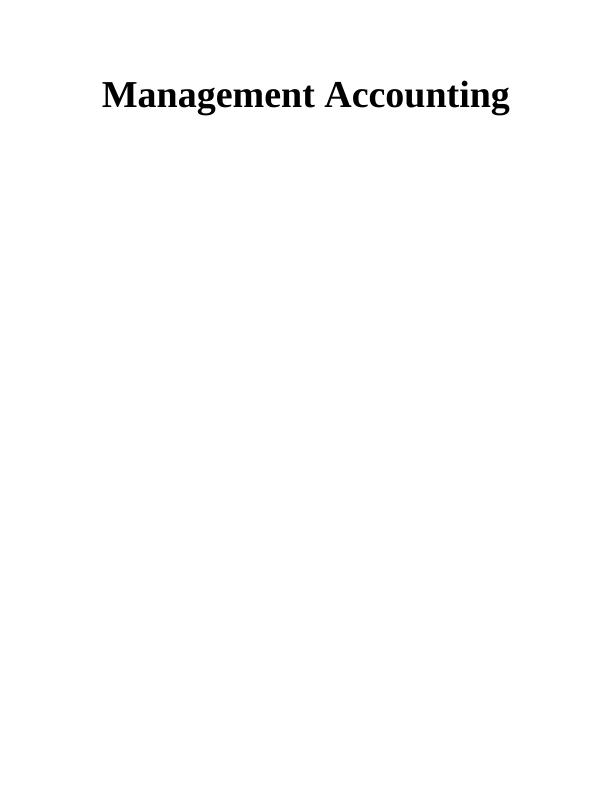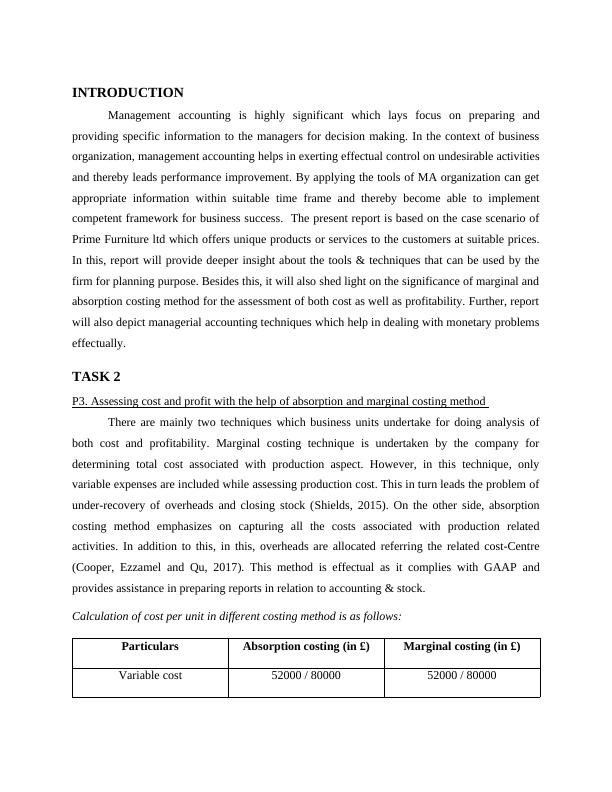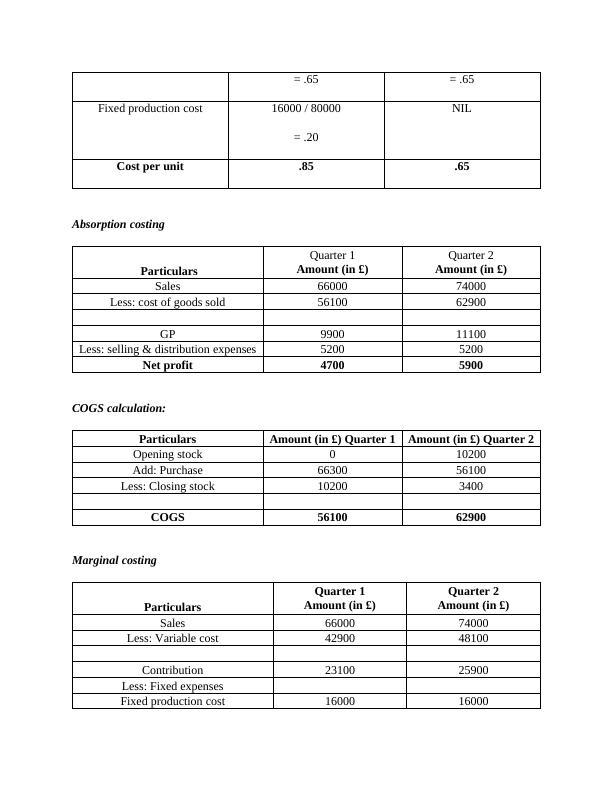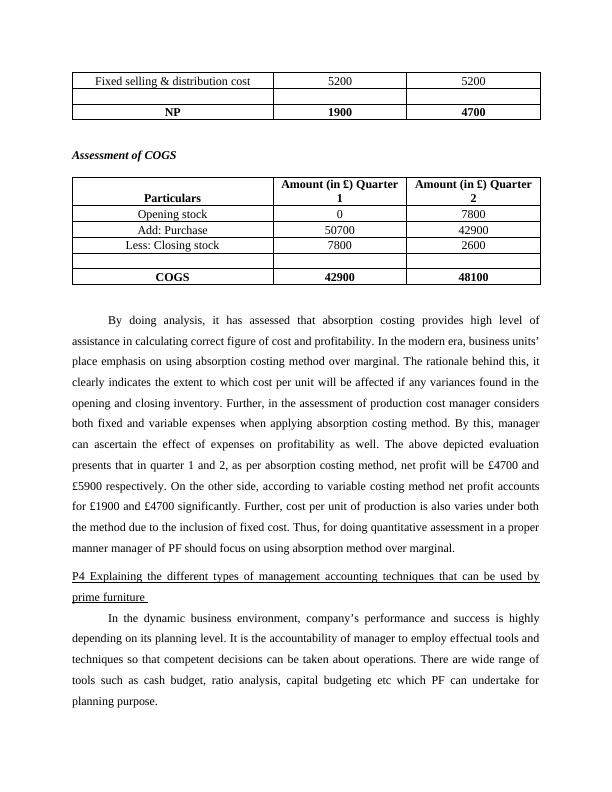Management Accounting: Tools and Techniques for Planning and Decision Making
Added on 2022-12-27
16 Pages3775 Words50 Views
Management Accounting

INTRODUCTION
Management accounting is highly significant which lays focus on preparing and
providing specific information to the managers for decision making. In the context of business
organization, management accounting helps in exerting effectual control on undesirable activities
and thereby leads performance improvement. By applying the tools of MA organization can get
appropriate information within suitable time frame and thereby become able to implement
competent framework for business success. The present report is based on the case scenario of
Prime Furniture ltd which offers unique products or services to the customers at suitable prices.
In this, report will provide deeper insight about the tools & techniques that can be used by the
firm for planning purpose. Besides this, it will also shed light on the significance of marginal and
absorption costing method for the assessment of both cost as well as profitability. Further, report
will also depict managerial accounting techniques which help in dealing with monetary problems
effectually.
TASK 2
P3. Assessing cost and profit with the help of absorption and marginal costing method
There are mainly two techniques which business units undertake for doing analysis of
both cost and profitability. Marginal costing technique is undertaken by the company for
determining total cost associated with production aspect. However, in this technique, only
variable expenses are included while assessing production cost. This in turn leads the problem of
under-recovery of overheads and closing stock (Shields, 2015). On the other side, absorption
costing method emphasizes on capturing all the costs associated with production related
activities. In addition to this, in this, overheads are allocated referring the related cost-Centre
(Cooper, Ezzamel and Qu, 2017). This method is effectual as it complies with GAAP and
provides assistance in preparing reports in relation to accounting & stock.
Calculation of cost per unit in different costing method is as follows:
Particulars Absorption costing (in £) Marginal costing (in £)
Variable cost 52000 / 80000 52000 / 80000
Management accounting is highly significant which lays focus on preparing and
providing specific information to the managers for decision making. In the context of business
organization, management accounting helps in exerting effectual control on undesirable activities
and thereby leads performance improvement. By applying the tools of MA organization can get
appropriate information within suitable time frame and thereby become able to implement
competent framework for business success. The present report is based on the case scenario of
Prime Furniture ltd which offers unique products or services to the customers at suitable prices.
In this, report will provide deeper insight about the tools & techniques that can be used by the
firm for planning purpose. Besides this, it will also shed light on the significance of marginal and
absorption costing method for the assessment of both cost as well as profitability. Further, report
will also depict managerial accounting techniques which help in dealing with monetary problems
effectually.
TASK 2
P3. Assessing cost and profit with the help of absorption and marginal costing method
There are mainly two techniques which business units undertake for doing analysis of
both cost and profitability. Marginal costing technique is undertaken by the company for
determining total cost associated with production aspect. However, in this technique, only
variable expenses are included while assessing production cost. This in turn leads the problem of
under-recovery of overheads and closing stock (Shields, 2015). On the other side, absorption
costing method emphasizes on capturing all the costs associated with production related
activities. In addition to this, in this, overheads are allocated referring the related cost-Centre
(Cooper, Ezzamel and Qu, 2017). This method is effectual as it complies with GAAP and
provides assistance in preparing reports in relation to accounting & stock.
Calculation of cost per unit in different costing method is as follows:
Particulars Absorption costing (in £) Marginal costing (in £)
Variable cost 52000 / 80000 52000 / 80000

= .65 = .65
Fixed production cost 16000 / 80000
= .20
NIL
Cost per unit .85 .65
Absorption costing
Particulars
Quarter 1
Amount (in £)
Quarter 2
Amount (in £)
Sales 66000 74000
Less: cost of goods sold 56100 62900
GP 9900 11100
Less: selling & distribution expenses 5200 5200
Net profit 4700 5900
COGS calculation:
Particulars Amount (in £) Quarter 1 Amount (in £) Quarter 2
Opening stock 0 10200
Add: Purchase 66300 56100
Less: Closing stock 10200 3400
COGS 56100 62900
Marginal costing
Particulars
Quarter 1
Amount (in £)
Quarter 2
Amount (in £)
Sales 66000 74000
Less: Variable cost 42900 48100
Contribution 23100 25900
Less: Fixed expenses
Fixed production cost 16000 16000
Fixed production cost 16000 / 80000
= .20
NIL
Cost per unit .85 .65
Absorption costing
Particulars
Quarter 1
Amount (in £)
Quarter 2
Amount (in £)
Sales 66000 74000
Less: cost of goods sold 56100 62900
GP 9900 11100
Less: selling & distribution expenses 5200 5200
Net profit 4700 5900
COGS calculation:
Particulars Amount (in £) Quarter 1 Amount (in £) Quarter 2
Opening stock 0 10200
Add: Purchase 66300 56100
Less: Closing stock 10200 3400
COGS 56100 62900
Marginal costing
Particulars
Quarter 1
Amount (in £)
Quarter 2
Amount (in £)
Sales 66000 74000
Less: Variable cost 42900 48100
Contribution 23100 25900
Less: Fixed expenses
Fixed production cost 16000 16000

Fixed selling & distribution cost 5200 5200
NP 1900 4700
Assessment of COGS
Particulars
Amount (in £) Quarter
1
Amount (in £) Quarter
2
Opening stock 0 7800
Add: Purchase 50700 42900
Less: Closing stock 7800 2600
COGS 42900 48100
By doing analysis, it has assessed that absorption costing provides high level of
assistance in calculating correct figure of cost and profitability. In the modern era, business units’
place emphasis on using absorption costing method over marginal. The rationale behind this, it
clearly indicates the extent to which cost per unit will be affected if any variances found in the
opening and closing inventory. Further, in the assessment of production cost manager considers
both fixed and variable expenses when applying absorption costing method. By this, manager
can ascertain the effect of expenses on profitability as well. The above depicted evaluation
presents that in quarter 1 and 2, as per absorption costing method, net profit will be £4700 and
£5900 respectively. On the other side, according to variable costing method net profit accounts
for £1900 and £4700 significantly. Further, cost per unit of production is also varies under both
the method due to the inclusion of fixed cost. Thus, for doing quantitative assessment in a proper
manner manager of PF should focus on using absorption method over marginal.
P4 Explaining the different types of management accounting techniques that can be used by
prime furniture
In the dynamic business environment, company’s performance and success is highly
depending on its planning level. It is the accountability of manager to employ effectual tools and
techniques so that competent decisions can be taken about operations. There are wide range of
tools such as cash budget, ratio analysis, capital budgeting etc which PF can undertake for
planning purpose.
NP 1900 4700
Assessment of COGS
Particulars
Amount (in £) Quarter
1
Amount (in £) Quarter
2
Opening stock 0 7800
Add: Purchase 50700 42900
Less: Closing stock 7800 2600
COGS 42900 48100
By doing analysis, it has assessed that absorption costing provides high level of
assistance in calculating correct figure of cost and profitability. In the modern era, business units’
place emphasis on using absorption costing method over marginal. The rationale behind this, it
clearly indicates the extent to which cost per unit will be affected if any variances found in the
opening and closing inventory. Further, in the assessment of production cost manager considers
both fixed and variable expenses when applying absorption costing method. By this, manager
can ascertain the effect of expenses on profitability as well. The above depicted evaluation
presents that in quarter 1 and 2, as per absorption costing method, net profit will be £4700 and
£5900 respectively. On the other side, according to variable costing method net profit accounts
for £1900 and £4700 significantly. Further, cost per unit of production is also varies under both
the method due to the inclusion of fixed cost. Thus, for doing quantitative assessment in a proper
manner manager of PF should focus on using absorption method over marginal.
P4 Explaining the different types of management accounting techniques that can be used by
prime furniture
In the dynamic business environment, company’s performance and success is highly
depending on its planning level. It is the accountability of manager to employ effectual tools and
techniques so that competent decisions can be taken about operations. There are wide range of
tools such as cash budget, ratio analysis, capital budgeting etc which PF can undertake for
planning purpose.

End of preview
Want to access all the pages? Upload your documents or become a member.
Related Documents
Management Accountinglg...
|11
|417
|50
Management Accounting: Cost Analysis, Planning Tools, and Techniqueslg...
|27
|3194
|314
Management Accounting: Tools and Techniques for Planninglg...
|17
|3871
|97
Management Accounting Techniques and Planning Toolslg...
|16
|3634
|455
Management Accounting: Costing Techniques, Budgetary Control, and Financial Analysislg...
|13
|3204
|33
Management Accounting: Calculation of Costs and Budgetary Controllg...
|13
|3204
|100
